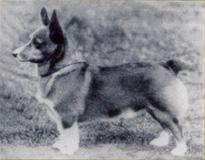
4 minute read
Bobtails – The Pembroke Welsh Corgi
Bobtails
in the Pembroke Welsh Corgi
When the first standard was written, it was only natural that it said “tail short, preferably natural” as a greater percentage of all pems at the time were born with natural short tails. Just look at the photos of the first greats, tail length varied from terrier tails to normal, short bobs, like you can see in Ch Rozavel Red Dragon, whose tail is very much the undocked bobs we normally see here today. In her book, “The Welsh Corgi” Thelma Gray writes, “Many Pembrokes are born tailless or with a very short stump, though half, three-quarter and full length tails are usual.” (Third Edition, page 41) opted for the natural short tail that is preferred in the standard. As we do not have the big kennels with large breeding stock, it was important that all breeders in the club pulled together and used our resources to the best of the breed. We turned to Peggy Gamble for help and several stud dogs and brood bitches with natural bobs were imported. These dogs were not of the quality our dogs then had, but we knew we had to sacrifice some generations in order to get what we wanted – the saucy little behind we were used to.
We realised that by breeding only from those few imports, our gene pool would be drastically depleted, so the long tails were looked upon as a gene bank for future generations, while the bob were bred to our best dogs and bitches, later on breeding the resulting bobs to dogs with full tails again, but still getting over 50% of the pups with short tails.
Nothing much was known about the gene at the time we started. It was assumed it was a dominant gene with incomplete penetrance, and we also assumed that the Welsh farmers of old would certainly not have opted for a dog with a natural bobtail unless this meant it was sound and functional, which was the main thing for a working farm dog. But rumours were aplenty; the bobtail lead to the lacking angulation in knee and hock, the bobtail caused kinky tails, the bobtail was related to defects in the spinal vertebrae, the bobtail lead to puppies being born without anus, but worst of all; the bobtail gene was lethal, causing litter sizes to go down,
Typical bobtail: Ch Rozavel Red Dragon whelped 1932
Where did this trait get lost, then? An old English breeder I spoke to about this, told me that when she got a bobtail in a litter, she stopped breeding from that bitch, as the bobs were so difficult to dock, and she found the docked behind so much neater. The same applied to all her friends in corgis. And we all know how easy it is to lose a dominant gene. This maens that mostly the gene “survived” where appearance was not the main thing – that is where the pem was kept as a working dog or merely a pet – although the occasional bob slipped through the breeding program in the bigger kennels as well. Stormerbanks used to get some, and in later years Peggy Gamble of the Blands Pembroke took a great interest in them and made sure the gene was preserved.
When the docking ban was enforced in Scandinavia in the late 80’s, the corgi clubs in the Nordic countries all had a different approach to the problem. In Norway, we Four present day bobtails: (Top left) A mature bitch, (Bottom left) 8 weeks pup, (Top right) 9 months male, (Bottom right) a mature male.
Of course the first generation of bobs were lacking in angulation behind, but that was not because of the bob, it was because our first imports were not show specimens, but solely brought into the breeding program for one reason and never line bred to. Bred to well-constructed dogs or bitches, some of the pups with short tails would inherit the construction of the sire, some of the dam, as in all breeding.
Some of the allegations were too far fetched to take seriously, others we decided to fight back not with opinions, but with facts. In this we enlisted the help of the Norwegian Kennel Club, Norwegian Veterinary Institute and the Norwegian University’s Department of Agriculture, the Corgi Club and the Kennel Club contributing the money, the others their time and knowledge.
First, both pems with natural short tails and also those with long tails from all lines in a number considered enough for the study to be relevant, were x-rayed and their vertebrae studied. The studies were conducted by Dr Astrid Indreboe at the Norwegian Veterinary Institute and have been published in veterinary journals as well as in our own newsletter. Her findings were conclusive; there are no signs whatsoever that the gene for a natural short tail leads to any defects in the spinal vertebrae, nor is it connected with the kinky tail that can be found in both short and long tails.
Republished with the kind permission of Anne Indergaard (Annwyn Welsh Corgis – Norway)
Dog World Breed Features
May 2021 Afghan Hound
June 2021 Cocker Spaniel

July 2021 August 2021 September 2021 Great Dane Fox Terrier Chihuahua
As always we are happy to receive your dog tales and stories for possible inclusion in upcoming issues of the Dog World magazine. All canine topics are welcome, including ‘paw inclusive’ coffee shops to dog-friendly accommodation or breeder’s topics. Simply send them through to barbara@dogsqueensland.org.au
To make a purchase call 3252 2661 or email barbara@dogsqueensland.org.au










